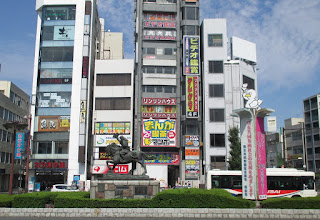We have the “Silver Week” holidays at this season. I resumed my Nakasendo Walk after an intermission of about three years (I concentrated in my Tokaido walk in this period).
Today’s
walk was from Kumagaya, the 8th shukuba station from Nihonbashi,
through Fukaya, the 9th station, to Okabe. All places are in Saitama
Prefecture.
Kumagaya
is the biggest city in the northern part of Saitama. It is historically famous
for Kumagaya Naozane, a samurai warload in the 11th century. His
statue (on a horse) stands in front of the JR Kumagaya Station.
The
rugby football is popular in the city. It plans to host matches in the Rugby
World Cup to be held in Japan in 2019. The PR board also stands before the station.
Nakasendo
goes through the Yagihashi department store in the center of the city (see the
top photo). The traditional buildings were all burnt out in air raids in the
World War 2. The department store were built on Nakasendo and the store kept
spaces for the Road.
I
saw the fields of rice and other agricultural products along Nakasendo as I
walked out of the central Kumagaya. The rice was just before the harvest. The
power transmission towers stand in the fields. I found birds there. (2nd photo from the top).
I
moved into Fukaya City. The city produces various agricultural products. It’s
Welsh onion is known as “Fukaya Negi”. The city’s gross agricultural production
is the largest in Saitama Prefecture.
I
found many fields growing Welsh onion, broccoli, cucumber and other vagitables.
There
remains the building of the main guest house in the shukuba station. An old
sake brewery with a brick-made chimney and other old buildings are also
preserved.
I
found the wholesale and retail stores of rice as I passed Fukaya station. The
PR sign of the special coupon to vitalize the local economy, called “chiiki
shinkou ken” was displayed in front of a store. The design of the sign was a
combination of Fukacchan, the city’s mascot character, and Shibusawa Ei-ichi,
the nation’s famous entrepreneur and business leader in the Meiji period who
was born in Fukaya.
There
are places to make and sell Japanese pickles, too. I saw old large barrels in a
garden of a farmer’s house.











No comments:
Post a Comment